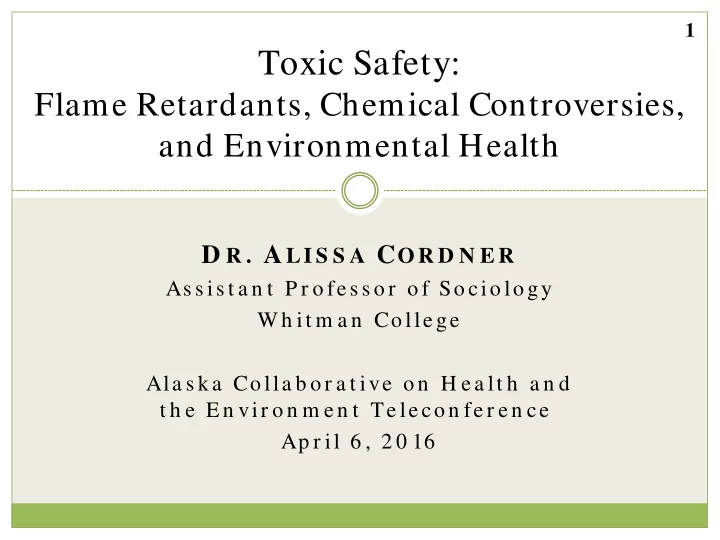

1 Toxic Safety: Flame Retardants, Chemical Controversies, and Environmental Health D R . A LI S S A C O R D N E R As s is t a n t P r o fe s s o r o f So cio lo gy Wh it m a n Co lle ge Ala s k a Co lla b o r a t ive o n H e a lt h a n d t h e E n vir o n m e n t Te le co n fe r e n ce Ap r il 6 , 2 0 16
2 Colum bia University Press, 2016
3 Research Questions How do stakeholders engaged in the field of flame 1. retardant chemicals define and act upon the risks and hazards of those chemicals? What is the role of scientific knowledge in decision- 2. making about chemical risks? What are the implications of stakeholders’ different 3. risk assessment paradigms for chemicals use and regulation in the United States?
4 Data and Methods Participant Observation Chemical manufacturer EPA’s Office of Pollution Prevention and Toxics EPA’s Office of Research and Development Academic environmental chemistry lab Environmental Health NGO 116 in-depth interviews Literature and public document research All respondents anonymized Funding: 3-year EPA STAR Fellowship (FP-917119) and NSF (PI: Phil Brown, SES-0924241)
5 Chemicals and Environmental Health ~100,000 chemicals have been inventoried in US commerce Exposure data – less than 1/ 5 of chemicals have any exposure data (Egeghy et al. 2012) Toxicity data –34% have no toxicity data and only 28% had a high quality toxicity evaluation (Judson et al. 2009)
6 Flame Retardant Chemicals Widely used as additives to consumer products to decrease flammability Hundreds of individual chemicals and mixtures PBDEs Chlorinated Tris (TDCPP, TCEP, TCPP) TBBPA HBCD Firemaster 550 (TBB and TBPH)
7 Fire Safety Regulations Intended to reduce fire occurrences, injuries, and deaths Annual Fire Deaths: 1971 – 12,000 2011 – 3,005 Source: US Fire Adm inistration Flame retardants remain a large and profitable international industry
8 Environmental Inequality
9 Health Effects of Some Flame Retardants Persistent, Bioaccum ulative, Toxic (PBT) Endocrine disruptors (Rudel and Perovich 2009) Reproductive disorders (Main et al. 2007, Harley et al. 2010) Neurological and behavioral outcom es in children (Roze et al. 2009, Herbstman et al. 2010, Messer 2010) Changes in horm one levels (Meeker et al. 2009, Chevrier et al. 2010)
10 Flame Retardants as Case Study TCEP Br-Tris PBBs TDCPP HBCD decaBDE FM550 TBBPA pentaBDE
11 Regulation of Flame Retardants Regulation has been chemical- by-chemical State level bans United States Environmental Protection Agency (EPA) Consumer Products Safety Commission (CPSC) Internationally Europe – Registration, Evaluation, and Authorization of Chemicals (REACH)
12 Limitations of Federal Chemicals Regulation Toxic Substances Control Act (TSCA) Limitations of TSCA include: Limited authority to regulate “existing” chemicals Risk-based regulations must be justified as “least burdensome” No required toxicity or exposure data for new chemicals Exemptions from full reporting for many chemicals Confidential Business Information Pending Federal Legislation
13 State Level Regulation and Activism Broad coalition, including: Environmental and health nonprofits Public interest organizations Parent groups Environmental scientists Legislators and regulators Supply chain manufacturers and distributors Firefighters Fire scientists and fire safety experts
14 Blue-Green Alliances Environmental groups have successfully partnered with firefighters and fire safety experts
15 State Level Regulation and Activism “Patchwork Quilt” of state regulations “Retail regulation” and market campaigns
16 Corporate Advocacy Citizens for Fire Safety (no longer active) Bromine Science and Environmental Forum American Chemistry Council’s North American Flame Retardant Alliance
17 Conceptual Risk Formulas Risk Hazard Exposure Uncertainty
18 Conceptual Risk Formulas Classic Risk Formula Exposure-Centric Risk Formula Either-Or Risk Formula Emerging Toxicology Risk Formula Exposure-Proxy Risk Formula Hazard-Centric Risk Formula
19 Classic Risk Formula Risk = f (Hazard * Exposure) Assumes a linear dose-response relationship Absence of data suggests absence of risk Widespread in environmental regulation, public discourse, and the chemical industry
20 Exposure-Centric Risk Formula Risk = f (Hazard * Physical-Chemical Properties * Use Scenarios * Exposure Pathways * Measured Levels) Formula is multifaceted and strictly multiplicative Exposure is controllable Widespread in the chemical industry
21 Either-Or Risk Formula Risk = f (Hazard) or f (Exposure) Critique of multiplicative risk assessment “We prefer a hazards-based approach, which is, ‘let’s look at the chemicals. If it’s hazardous, don’t use it.’” OR “You don’t even have to show a health effect. If you’re showing that these chemicals are getting into my body, that trespass is unauthorized.” Widespread in environmental and health activism
22 Implications of Conceptual Risk Definition Risk definition is strategic Reactionary versus precautionary risk management Protecting markets versus protecting public health Risk definition as another tool used by industry to delay chemicals management
23 Questions ? Alissa Cordner cordneaa@whitman.edu Toxic Safety is available for purchase on the Columbia University website (cup.columbia.edu). Use the discount code CORTOX for a 30% discount.
Recommend
More recommend